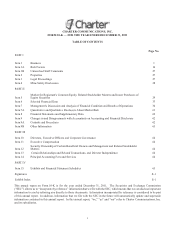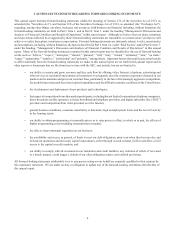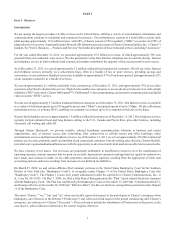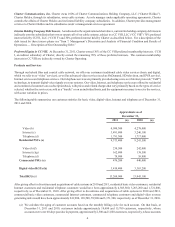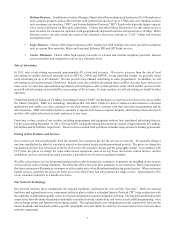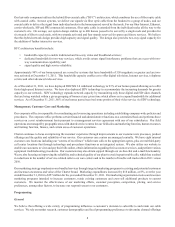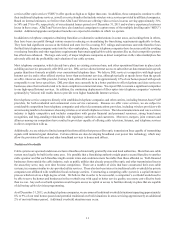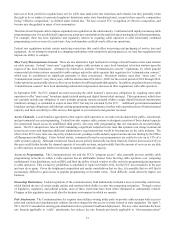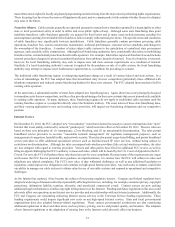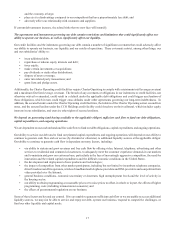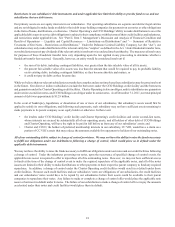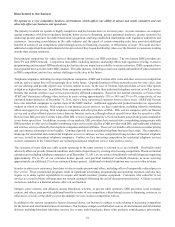Charter 2011 Annual Report Download - page 21
Download and view the complete annual report
Please find page 21 of the 2011 Charter annual report below. You can navigate through the pages in the report by either clicking on the pages listed below, or by using the keyword search tool below to find specific information within the annual report.9
in each of our markets. We obtain basic and premium programming from a number of suppliers, usually pursuant to written
contracts. Our programming contracts generally continue for a fixed period of time, usually from three to ten years, and are subject
to negotiated renewal. Some programming suppliers offer financial incentives to support the launch of a channel and/or ongoing
marketing support. We also negotiate volume discount pricing structures. We have more recently negotiated for more content
rights allowing us to provide programming on-line to our authenticated customers. Programming costs are usually payable each
month based on calculations performed by us and are generally subject to annual cost escalations and audits by the programmers.
Costs
Programming is usually made available to us for a license fee, which is generally paid based on the number of customers to whom
we make such programming available. Such license fees may include “volume” discounts available for higher numbers of
customers, as well as discounts for channel placement or service penetration. Some channels are available without cost to us for
a limited period of time, after which we pay for the programming. For home shopping channels, we receive a percentage of the
revenue attributable to our customers’ purchases, as well as, in some instances, incentives for channel placement.
Our programming costs have increased in every year we have operated in excess of customary inflationary and cost-of-living type
increases. We expect them to continue to increase due to a variety of factors including amounts paid for retransmission consent,
annual increases imposed by programmers with additional selling power as a result of media consolidation and additional
programming, including new sports services and non-linear programming for on-line and OnDemand programming. In particular,
sports programming costs have increased significantly over the past several years. In addition, contracts to purchase sports
programming sometimes provide for optional additional games to be added to the service and made available on a surcharge basis
during the term of the contract.
Federal law allows commercial television broadcast stations to make an election between “must-carry” rights and an alternative
“retransmission-consent” regime. When a station opts for the retransmission-consent regime, we are not allowed to carry the
station’s signal without the station’s permission. Continuing demands by owners of broadcast stations for cash payments at
substantial increases over amounts paid in prior years in exchange for retransmission consent will likely increase our programming
costs or require us to cease carriage of popular programming, potentially leading to a loss of customers in affected markets.
Over the past several years, increases in our video service rates have not fully offset increasing programming costs, and with the
impact of increasing competition and other marketplace factors, we do not expect them to do so in the foreseeable future. Although
in 2010, we began passing along a portion of amounts paid for retransmission consent to the majority of our customers, our inability
to fully pass these programming cost increases on to our video customers has had and is expected in the future to have an adverse
impact on our cash flow and operating margins associated with the video product. In order to mitigate reductions of our operating
margins due to rapidly increasing programming costs, we continue to review our pricing and programming packaging strategies,
and we plan to continue to migrate certain program services from our basic level of service to our digital tiers and limit the launch
of non-essential, new networks. As we migrate our programming to our digital tier packages, certain programming that was
previously available to all of our customers via an analog signal may only be part of an elective digital tier package offered to our
customers for an additional fee. As a result, we expect that the customer base upon which we pay programming fees will
proportionately decrease, and the overall expense for providing that service will also decrease. However, reductions in the size
of certain programming customer bases may result in the loss of specific volume discount benefits.
We have programming contracts that have expired and others that will expire at or before the end of 2012. We will seek to
renegotiate the terms of these agreements. There can be no assurance that these agreements will be renewed on favorable or
comparable terms. To the extent that we are unable to reach agreement with certain programmers on terms that we believe are
reasonable, we have been, and may in the future be, forced to remove such programming channels from our line-up, which may
result in a loss of customers.
Franchises
As of December 31, 2011, our systems operated pursuant to a total of approximately 3,100 franchises, permits, and similar
authorizations issued by local and state governmental authorities. Such governmental authorities often must approve a transfer
to another party. Most franchises are subject to termination proceedings in the event of a material breach. In addition, most
franchises require us to pay the granting authority a franchise fee of up to 5.0% of revenues as defined in the various agreements,
which is the maximum amount that may be charged under the applicable federal law. We are entitled to and generally do pass
this fee through to the customer.


